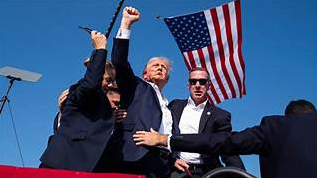The photograph of a bloodied Trump has turned him into a hero and captured the carnage of American politics.
To awkwardly frame the question: when did the photographs of the attempted assassination of Donald Trump begin to emerge? How far back do we have to go to fully understand the impact of Joe Biden’s missteps at the NATO summit?
In 1967, John Berger published an essay in which he drew attention to the striking parallels between a photograph of Che Guevara’s recently displayed corpse and Rembrandt’s 1632 painting The Anatomy Lesson of Dr Nicolaes Tulp. Berger, with his forensic attention to detail, noted how both images served similar purposes: one aimed at advancing medical knowledge, the other served as a political warning. He followed up this essay with another in December of the same year, considering the death of Guevara in greater depth. His knack for juxtaposing revered historical art with modern, mass-produced images—like the nudes of Rubens with magazine covers from the past—was to become a hallmark of his influential BBC series Ways of Seeing, which left an indelible mark on the public’s understanding of visual culture.
Fast forward to 2024, and the photograph of a bloodied Donald Trump following the assassination attempt takes on a similar, albeit more contemporary, significance. Just as the image of Guevara’s body captured the political tension of its time, the photograph of Trump, violently wounded yet still standing as a defiant symbol, encapsulates the deep divisions and carnage of American politics today.
For many of Trump’s supporters, this moment, captured in the bloodied image, has turned him into a martyr and a hero. The image itself is not just a portrayal of violence but a symbol of the battle he claims to fight: standing up against what he perceives as an establishment bent on crushing him. This transformation of Trump into a political icon reflects the ongoing spectacle of American politics, where spectacle and visual representation often become more powerful than policy or reason.
In many ways, the photograph has captured the essence of the political conflict consuming the United States—a conflict not just of ideologies but of identities, power, and narratives. Much like the images of Guevara, it will likely be remembered for how it solidified an image of resistance and martyrdom in the public consciousness, despite the violence it depicted. For better or for worse, it is now an indelible part of the story of American politics

